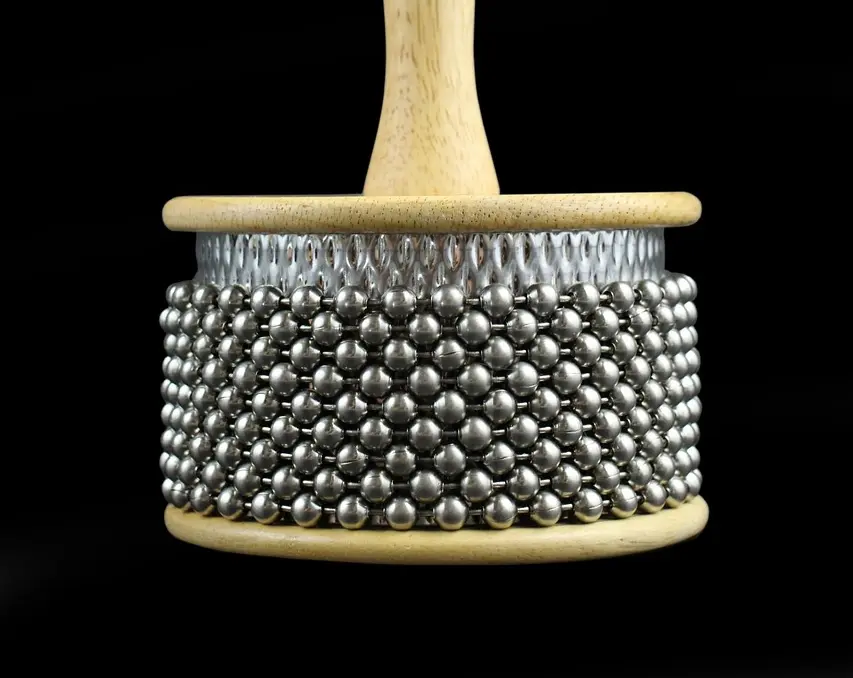A cabasa is a unique percussion instrument that falls under the category of shaken idiophones or rattles.
It is made up of loops of steel ball chains wrapped around a wooden cylinder fixed to a handle.
The cabasa is commonly used in Latin jazz and bossa nova music, adding a rhythmic and dynamic layer to performances. Its versatility and unique sound make it a fascinating instrument to explore.
In this article, you will learn exactly what is a Cabasa musical instrument, its definition, sound, types, playing techniques, benefits, and more.

Content
Types of Cabasas
Developed in the 1960s by Martin Cohen, the founder of Latin Percussion, the cabasa produces a distinctive metallic, rattling sound. Think of it as similar to the sound of a rattlesnake!
There are different variations of cabasas available, each with its unique design and sound.
Whether you’re drawn to the traditional African cabasa, the Latin American cabaça, or the modern cabasas offered by renowned brands, there’s a wide range of options to choose from.
African Cabasa (Agbe)
The African cabasa, also known as Agbe, is a traditional version of the instrument. It is crafted from dried gourds, with beads strung on the outer surface.
The combination of the gourd and beads creates a distinct sound that adds an authentic African flavor to the music.
Latin American Cabasa (Cabaça)
In Latin American dance music, the cabaça is often the cabasa of choice. This variation features a round or pear-shaped gourd covered with a network of beads, ending in a single handle.
The cabaça offers a different tonal quality and playing experience compared to other types of cabasas, adding variety to your musical repertoire.
Modern Cabasas
Brands like Latin Percussion and Meinl Percussion offer modern cabasas in various sizes and designs.
These cabasas are constructed with durable materials, allowing for a consistent sound and reliable performance. With different sizes and designs available, you can choose a cabasa that suits your preferences and playing style.
Cabasa Playing Techniques
To fully explore the rhythmic potential of the cabasa, it is essential to understand the proper playing techniques. By mastering these techniques, you can unlock a world of expressive possibilities and enhance your musical performances.
Start by holding the cabasa with one hand on the metal chain and the other hand gripping the handle firmly. This grip allows you to maintain control and stability while playing.
Once you have a secure grasp, begin by twisting the cabasa back and forth. This twisting motion causes the metal chain loops to rub against the cylinder, producing a unique rattling sound.
Experiment with different twisting speeds and amplitudes to create rhythmic patterns and variations. By adjusting the pressure applied to the chain with your non-dominant hand, you can also control the tone and volume of the instrument.
As you become more proficient with the cabasa, you can explore advanced techniques such as playing rhythms with one hand while introducing accents or syncopations with the other hand.
These techniques add depth and complexity to your playing, allowing you to create intricate rhythms and textures.
Remember, the key to mastering cabasa playing techniques lies in practice and experimentation. Dedicate time to develop your skills and explore the instrument’s sonic possibilities.
By doing so, you can elevate your musical performances and captivate your audience with the captivating sounds of the cabasa.
| Technique | Description |
|---|---|
| Twisting | Rotate the cabasa back and forth to create rhythmic patterns. |
| Pressure Control | Adjust the pressure applied to the chain to control the tone and volume. |
| Advanced Rhythms | Play complex rhythms, accents, and syncopations with both hands for added complexity. |
Benefits of Playing the Cabasa
The cabasa is not only a fascinating percussion instrument, but it also offers a range of benefits to those who play it.
Whether you’re a professional musician or a beginner, incorporating the cabasa into your musical repertoire can have a positive impact on your musical journey and overall well-being.
1. Versatility in Musical Styles
One of the greatest advantages of playing the cabasa is its versatility in various musical styles.
Whether you’re interested in Latin jazz, world music, or contemporary pop, the cabasa can seamlessly blend in and add a distinct rhythmic texture to your compositions. Its unique metallic rattling sound creates a captivating sonic experience that enhances the overall musicality.
2. Accessibility for All
The cabasa is an instrument that requires minimal hand movement to produce rhythmic patterns and sounds.
This makes it accessible to individuals with physical or neurological disabilities who may face challenges with more complex percussion instruments. Its simplicity allows players of all abilities to express themselves musically and enjoy the joy of creating captivating rhythms.
3. Music Therapy Benefits
The cabasa has found a place in music therapy for its ability to promote fluent hand movements and build neurological connections between movement and sound. The instrument facilitates motor coordination, helping individuals build dexterity and control with their hands.
Through music therapy, the cabasa can be an effective tool in supporting individuals with neurological conditions or recovering from physical injuries.
4. Enhanced Coordination and Rhythm Skills
Playing the cabasa requires coordination between both hands, as one hand twists the instrument while the other holds the handle.
This coordination strengthens the connection between the brain and motor skills, improving hand-eye coordination and overall rhythm skills. Regular practice with the cabasa can enhance your ability to maintain a steady beat and develop a sense of timing in music.
5. Boost in Creativity
The cabasa’s unique sound and rhythmic capabilities allow for creative exploration. As you become more proficient in playing the cabasa, you can experiment with different patterns, accents, and syncopations, giving your musical compositions a distinctive and expressive touch.
The instrument sparks creativity and encourages musicians to think outside the box when it comes to rhythmic arrangements.
Overall, the cabasa offers a wide range of benefits to its players, from musical versatility and accessibility to therapeutic applications and enhanced coordination skills.
Whether you’re a professional musician or a beginner, incorporating the cabasa into your musical journey can be a rewarding experience.
Popular Cabasa Players
The cabasa has been embraced by numerous renowned musicians, showcasing its unique sound and versatile abilities.
One notable example is Paulinho da Costa, a highly skilled percussionist who has collaborated with renowned artists including the legendary Michael Jackson. You can hear Paulinho da Costa’s masterful cabasa playing on tracks like “Your Ways” from The Jackson 5’s 1980 Triumph album.
Another noteworthy cabasa player is Lennie Castro, whose talent has graced the performances of various Latin jazz and bossa nova musicians, enriching their distinctive sound.
These talented artists exemplify the diverse range of musical genres and styles where the cabasa finds its place, elevating compositions with its rhythmic intricacies.
Their contributions have solidified the cabasa’s position as a sought-after instrument in the world of percussion.
Cabasa for Beginners
If you’re new to percussion and looking for an instrument to start with, the cabasa is a great choice. With its simple technique and minimal hand movement, it’s easy for beginners to learn and play.
When starting, you can experiment with different twisting motions to produce a variety of sounds and rhythms.
By twisting the handle back and forth, you can create rhythmic patterns and explore the instrument’s unique sonic possibilities.
To further develop your skills, it’s essential to learn basic rhythmic patterns and incorporate them into your practice sessions. This will help you improve your timing, precision, and overall musical expression with the cabasa.
Whether you’re a complete beginner or have some musical experience, the cabasa offers a fun and accessible avenue for exploring percussion. So grab a cabasa, start twisting, and let your rhythm flow!
Learning Cabasa Skills

To enhance your cabasa skills, it is important to practice with different tempos and music styles. This will help you develop control over the twisting motion and allow you to apply varying degrees of pressure to the chain, resulting in different dynamics and articulations.
One great way to improve your cabasa technique is to watch video tutorials or take lessons from experienced cabasa players.
They can provide valuable guidance and offer tips on how to refine your playing technique and explore the instrument’s rhythmic versatility.
Practicing regularly with dedication and perseverance will allow you to progress and master the cabasa. Experimenting with different techniques and incorporating them into your practice sessions will help you develop your own unique playing style.
Learning from others and seeking feedback on your playing can also accelerate your progress. Joining a community of percussionists or participating in workshops and masterclasses can provide opportunities to connect with fellow cabasa enthusiasts and learn from each other’s experiences.
Remember, learning any instrument takes time and patience. Embrace the journey and enjoy the process of honing your cabasa skills. With practice and dedication, you will unlock the full rhythmic potential of this versatile percussion instrument.
Explore the Cabasa’s Rhythmic Versatility
The cabasa is a truly versatile instrument, offering a wide range of rhythmic possibilities that can enhance any musical genre.
Its distinct metallic rattling sound can blend seamlessly with different styles of music, whether you’re playing Latin jazz, bossa nova, world music, or even contemporary pop.
With the cabasa, you have the freedom to experiment with various patterns, accents, and syncopations, allowing you to add depth and texture to your musical compositions.
Its rhythmic versatility empowers you to create unique and captivating arrangements that will captivate both musicians and audiences alike.
Whether you’re a percussionist looking to expand your rhythmic repertoire or a composer seeking to incorporate new sounds into your compositions, the cabasa is a fantastic instrument to explore.
Let your creativity flourish as you harness the rhythmic potential of the cabasa, creating unforgettable music that resonates with your listeners.
Experience the rhythmic versatility of the cabasa and unlock a world of musical possibilities. Incorporate its metallic rattling sound into your compositions, infusing them with a unique character and rhythmic depth.
